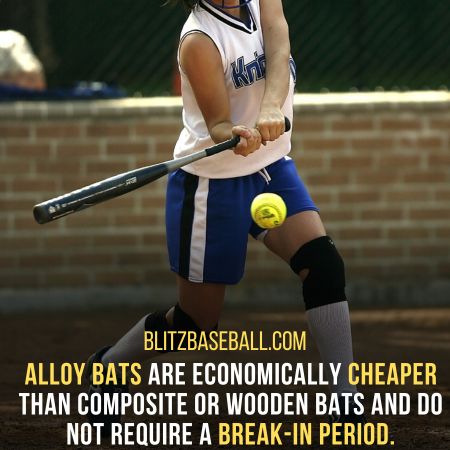The article titled ‘Alloy VS Composite Bat Basic (This is Not a Science Class)’ delves into the topic of alloy and composite bats, providing readers with a comprehensive understanding of the differences between these two types of baseball bats.
Bats are typically made of either alloy or composite materials, each possessing distinct characteristics and advantages. Alloys are solid forms of metals that can conduct electricity, while composites are non-metal mixtures made of more than two elements.
Alloy bats are known for their durability and affordability, producing a distinct sound. On the other hand, composite bats are lightweight, offer a larger sweet spot, and absorb vibrations effectively.
The article explores the composition differences, and performance factors, and guides readers in choosing the right bat for their needs.
By offering objective and informative insights, this article aims to assist readers in making an informed decision when selecting their baseball bat.
Key Takeaways
- Alloy bats are economically cheaper than composite or wooden bats and do not require a break-in period.
- Composite bats are lightweight with a long sweet spot and reduced vibration, but they are more expensive and require a break-in period.
- Alloy bats are long-lasting and produce more sound, while composite bats have a two-piece design and absorb vibrations easily.
- Beginners may prefer composite bats for a larger hitting surface, while more experienced players may prefer alloy bats.
Bat Types: Alloy Vs Composite Bat

The types of bats commonly used in baseball are alloy bats and composite bats, each having their own unique characteristics and advantages.
Alloy bats are made of a solid form of two or more metals. They are known for their durability and long-lasting nature. Alloy bats are also economically cheaper compared to composite or wooden bats.
On the other hand, composite bats like BBCOR and USSA are made of a non-metal mixture of more than two elements. They are lightweight and provide a long sweet spot, reducing vibration upon contact with the ball.
While composite bats may outperform alloy bats in terms of performance, they are more expensive and require a break-in period.
Additionally, the weight of the bat is an important factor to consider. Alloy bats provide concentrated weight for a good swing, while composite bats are lightweight and increase length without being heavy.
Composition Differences
Composition differences between alloy and composite bats can impact their performance and durability.
Advantages of alloy bats:
- Long-lasting and durable
- Produce more sound, which may enhance a player’s confidence
- Economically cheaper than composite or wooden bats
- Do not require a break-in period
- Provide concentrated weight for a good swing
Advantages of composite bats:
- Lightweight with a long sweet spot, allowing for increased hitting power
- Absorb vibrations easily, reducing hand sting
- The two-piece design allows for better weight distribution and improved bat speed
- More forgiving on mishits, resulting in better overall performance
- Can outperform alloy bats in terms of distance and power

Disadvantages of alloy bats:
- Can be more prone to denting and cracking
- May cause more hand sting on mishits
- Limited sweet spot compared to composite bats
- Limited options for customization
Disadvantages of composite bats:
- More expensive than alloy bats
- Require a break-in period for optimal performance
- Susceptible to cracking in cold weather
- May not produce the same sound and feel as alloy bats
- Limited lifespan due to potential delamination of composite layers.
Performance Factors
Performance factors of alloy and composite bats include various aspects that can influence a player’s hitting ability and overall game performance. One important factor to consider is bat durability.
Alloy bats are known for their long-lasting nature, as they are made from solid forms of metals. They are less likely to crack or break compared to composite bats, which are made from a mixture of non-metal elements.
On the other hand, composite bats are generally lighter and have a longer sweet spot, which can result in improved swinging performance.
Another factor to consider is the cost comparison between alloy and composite bats. Alloy bats are economically cheaper than composite bats, making them a more affordable option for players. Composite bats, on the other hand, tend to be more expensive due to the manufacturing process and materials used.
Ultimately, the choice between alloy and composite bats depends on the player’s personal preferences and budget.
Choosing the Right Bat
When selecting a bat, it is important to consider various factors to ensure the right choice is made. Two crucial factors to consider are bat weight and bat length.
The weight of a bat can greatly impact a player’s swing speed and control. It is essential to choose a bat that is not too heavy, as this can result in decreased bat speed and difficulty in making solid contact with the ball. On the other hand, a bat that is too light may lack the necessary power behind each swing.
Similarly, the length of a bat is important in achieving proper form and maximizing hitting performance.
A bat that is too long can lead to a slower swing and difficulty in making contact with pitches, while a bat that is too short may limit the player’s reach and power.
Therefore, carefully considering the weight and length of the bat is crucial in choosing the right one for optimal performance.

Frequently Asked Questions
What is the difference between an alloy bat and a composite bat in terms of durability?
The durability of alloy bats and composite bats can be compared in terms of performance and cost. Alloy bats are long-lasting and economically cheaper, while composite bats may outperform alloy bats but are more expensive and require a break-in period.
Can a composite bat be used in cold weather?
The performance of a composite bat can be impacted by cold weather. Low temperatures can cause the composite material to become stiffer, resulting in reduced bat performance. Alloy bats may be more suitable for cold weather conditions.
Are alloy bats more suitable for beginners or experienced players?
Alloy bats have pros and cons for different skill levels. For beginners, alloy bats are more suitable as they are cheaper, long-lasting, and do not require a break-in period. However, experienced players may prefer alloy bats for their concentrated weight and increased swing power. Comparing performance, composite bats are lightweight with a larger hitting surface, making them ideal for beginners. Experienced players may prefer the durability and sound produced by alloy bats.
Do alloy bats require any maintenance or break-in period?
Alloy bats do not require any maintenance or break-in period. They are ready to use right away.
What are the advantages of using a composite bat over an alloy bat?
Composite bats have advantages over alloy bats in terms of performance and cost. They offer a larger hitting surface, reduced vibration, and a longer sweet spot. However, they are more expensive and require a break-in period.
Conclusion
In conclusion, alloy and composite bats have distinct characteristics that cater to different preferences and skill levels.
Alloy bats are durable, produce a satisfying sound, and are economically cheaper.
On the other hand, composite bats are lightweight, have a large sweet spot, and absorb vibrations well.
While composite bats may outperform alloy bats, they are more expensive and require a break-in period.
Ultimately, the choice between alloy and composite bats depends on individual preferences and playing style.
Consider Marucci baseball bats for a quality option in 2023.
